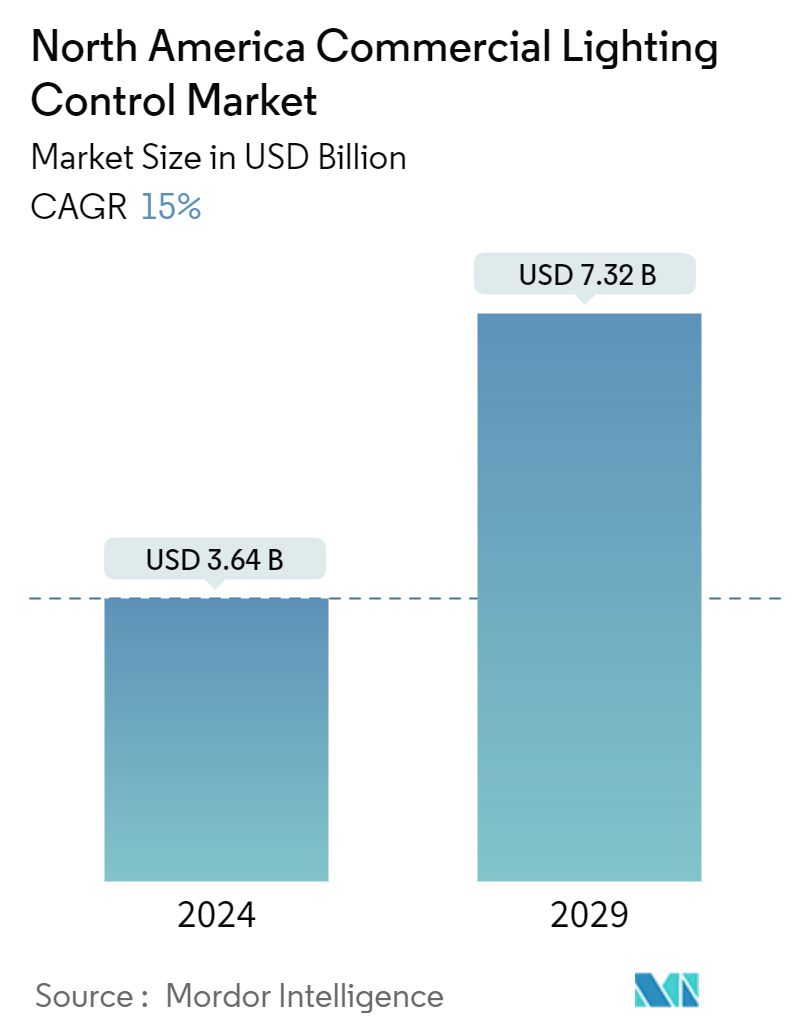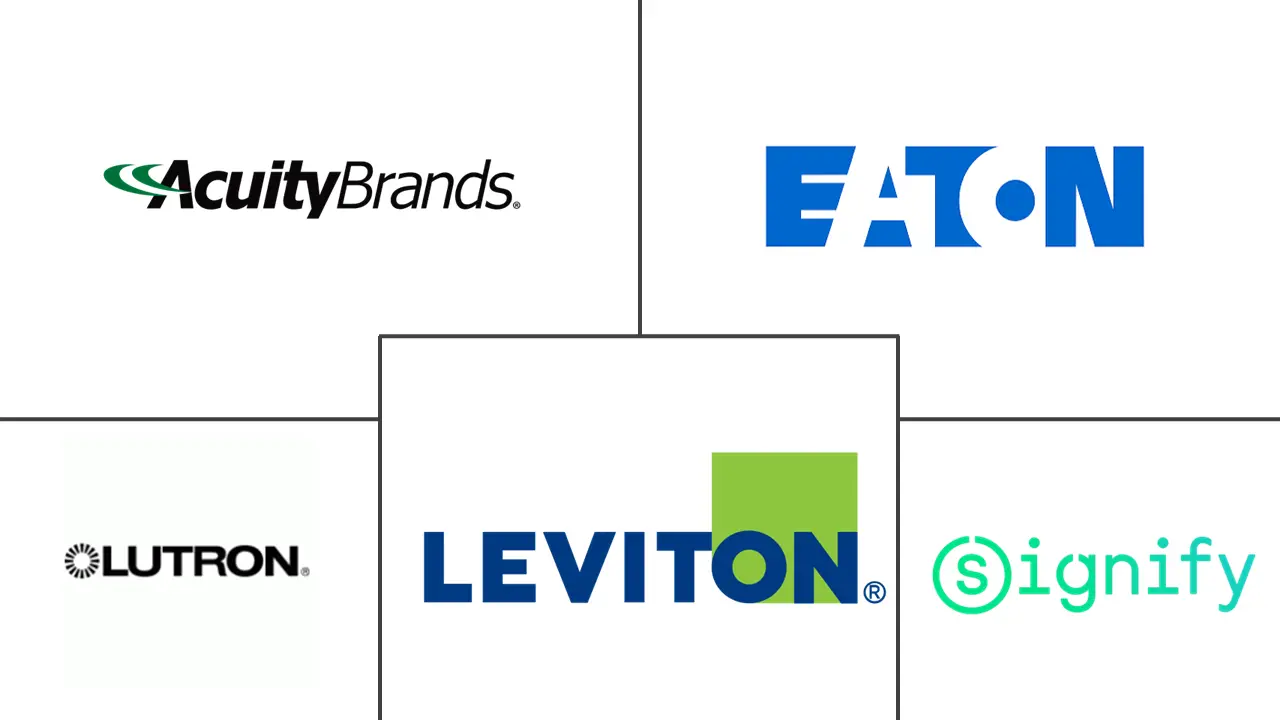Market Size of North America Commercial Lighting Control Industry

| Study Period | 2019 - 2029 |
| Base Year For Estimation | 2023 |
| Market Size (2024) | USD 3.64 Billion |
| Market Size (2029) | USD 7.32 Billion |
| CAGR (2024 - 2029) | 15.00 % |
| Market Concentration | Low |
Major Players
*Disclaimer: Major Players sorted in no particular order |
North America Commercial Lighting Control Market Analysis
The North America Commercial Lighting Control Market size is estimated at USD 3.64 billion in 2024, and is expected to reach USD 7.32 billion by 2029, growing at a CAGR of 15% during the forecast period (2024-2029).
• The United States and Canada are the most prominent countries in North America that favor energy-saving lighting controls over conventional systems. These systems' significant producers and suppliers are located in North America, where their products are used for commercial or industrial indoor lighting applications. This area's growth is driven by demand from different sectors, prominent competitors, and product manufacturers of lighting control systems.
• Moreover, the Department of Energy (DOE) and the Federal Energy Regulatory Council (FERC) oversee energy regulation in the United States. These agencies lay down the national policy the commercial lighting sector must follow. For instance, open-plan office spaces, cafeteria dining facilities, and quick restaurants are often equipped with occupant sensor controls. Under Title 24 regulations, rules must be set to control general lighting within the 'zones' where the floor area is at most 600 square meters. After 20 minutes for occupants to leave a particular zone, all lights shall be switched off in any monitored area.
• The wired communication system offers many advantages, such as enhanced security, reduced maintenance costs, and improved energy efficiency, and is used in all types of commercial settings in the region. The growing demand for automatic lighting systems is one of the significant factors that has fueled growth in wired communication. As a result of their lower cost and higher energy efficiency, the use of automated lighting solutions is increasing.
• There is an inverse relationship between temperature and the performance of light-emitting diodes and the products utilizing them. As LED lights are powered by electricity and produce heat, the output will differ according to junction temperature. Such a barrier has prevented the widespread adoption of intelligent lighting control systems. However, factors such as the declining price of LEDs and significant energy savings achieved by carrying out energy-efficient lighting control systems are expected to reduce the effect of this limitation in the short term.
• The factors at the macroeconomic level, such as supply chain disruptions due to events like natural disasters and geopolitical tensions, can affect the availability of components, raw materials, and finished products. This can result in delays in the production and delivery of various products, including LED drivers, sensors, switches, dimmers, relay units, and gateways, ultimately slowing market growth. Additionally, more infrastructure development in both rural and urban areas may ensure the adoption of lighting control systems, thereby restricting opportunities for market growth.
North America Commercial Lighting Control Industry Segmentation
For market estimation, we have tracked the revenue generated from the sale of types of hardware and software offered by different market players for a diverse range of applications. The market trends are evaluated by analyzing the investments made in product innovation, diversification, and expansion. Further, the advancements in wired and wireless communication protocols are also crucial in determining the growth of the studied market.
The North American commercial lighting control market is segmented by type (hardware [LED driver, sensors and switches and dimmers, relay units, gateways], software), by communication protocol (wired, wireless), and by country (United States, Canada). The report offers market forecasts and size in value (USD) for all the above segments.
| By Type | |||||||
| |||||||
| Software |
| By Communication Protocol | |
| Wired | |
| Wireless |
| By Country | |
| United States | |
| Canada |
North America Commercial Lighting Control Market Size Summary
The North American commercial lighting control market is poised for significant growth, driven by the increasing adoption of energy-efficient lighting solutions in the United States and Canada. These countries are at the forefront of integrating advanced lighting control systems, which are predominantly used in commercial and industrial settings. The market's expansion is supported by a robust regulatory framework from entities like the Department of Energy and the Federal Energy Regulatory Council, which mandate energy-saving measures in commercial spaces. The shift towards wired and wireless communication systems, including Bluetooth mesh networking, is enhancing the efficiency and ease of installation of lighting controls, further propelling market growth. The demand for automated and intelligent lighting solutions is rising, as they offer improved energy efficiency and reduced operational costs, making them an attractive option for various commercial applications.
The market landscape is highly competitive, with major players such as Acuity Brands, Eaton Corporation, Lutron Electronics, and Signify Holding leading the charge. These companies are actively engaging in strategic collaborations and acquisitions to enhance their product offerings and expand their market presence. The widespread adoption of LED technology across retail, office, and public sector buildings is a key driver of market growth, as it significantly reduces energy consumption and operational expenses. The market is also witnessing a trend towards wireless lighting control systems, which offer easier installation and maintenance compared to traditional wired systems. As infrastructure development continues in both urban and rural areas, the adoption of advanced lighting control systems is expected to increase, further contributing to the market's expansion.
North America Commercial Lighting Control Market Size - Table of Contents
-
1. MARKET INSIGHTS
-
1.1 Market Overview
-
1.2 Industry Attractiveness - Porter's Five Forces Analysis
-
1.2.1 Threat of New Entrants
-
1.2.2 Bargaining Power of Buyers/Consumers
-
1.2.3 Bargaining Power of Suppliers
-
1.2.4 Threat of Substitute Products
-
1.2.5 Intensity of Competitive Rivalry
-
-
1.3 Technology Snapshot
-
1.4 Impact of COVID-19 Aftereffects and Other Macroeconomic Factors on the Market
-
-
2. MARKET SEGMENTATION
-
2.1 By Type
-
2.1.1 Hardware
-
2.1.1.1 LED Drivers
-
2.1.1.2 Sensors
-
2.1.1.3 Switches and Dimmers
-
2.1.1.4 Relay Units
-
2.1.1.5 Gateways
-
-
2.1.2 Software
-
-
2.2 By Communication Protocol
-
2.2.1 Wired
-
2.2.2 Wireless
-
-
2.3 By Country
-
2.3.1 United States
-
2.3.2 Canada
-
-
North America Commercial Lighting Control Market Size FAQs
How big is the North America Commercial Lighting Control Market?
The North America Commercial Lighting Control Market size is expected to reach USD 3.64 billion in 2024 and grow at a CAGR of 15% to reach USD 7.32 billion by 2029.
What is the current North America Commercial Lighting Control Market size?
In 2024, the North America Commercial Lighting Control Market size is expected to reach USD 3.64 billion.

